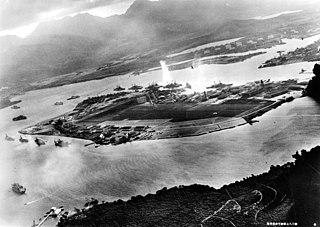
The attack on Pearl Harbor was a surprise military strike by the Imperial Japanese Navy Air Service on the American naval base at Pearl Harbor in Honolulu, Hawaii, the United States, just before 8:00 a.m. on Sunday, December 7, 1941. At the time, the United States was a neutral country in World War II. The attack on Hawaii and other U.S. territories led the United States to formally enter World War II on the side of the Allies the day following the attack, on December 8, 1941. The Japanese military leadership referred to the attack as the Hawaii Operation and Operation AI, and as Operation Z during its planning.
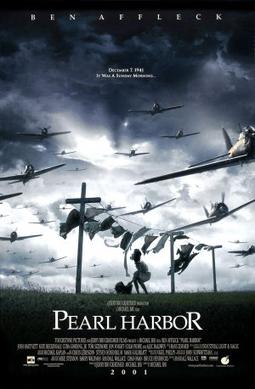
Pearl Harbor is a 2001 American romantic war drama film directed by Michael Bay, produced by Bay and Jerry Bruckheimer and written by Randall Wallace. Starring Ben Affleck, Kate Beckinsale, Josh Hartnett, Cuba Gooding Jr., Tom Sizemore, Jon Voight, Colm Feore, and Alec Baldwin, the film features a heavily fictionalized version of the attack on Pearl Harbor, focusing on a love story set amidst the lead up to the attack, its aftermath, and the Doolittle Raid.

USS Enterprise (CV-6) was a Yorktown-class carrier built for the United States Navy during the 1930s. She was the seventh U.S. Navy vessel of that name. Colloquially called "The Big E", she was the sixth aircraft carrier of the United States Navy. Launched in 1936, she was the only Yorktown-class and one of only three American fleet carriers commissioned before World War II to survive the war.
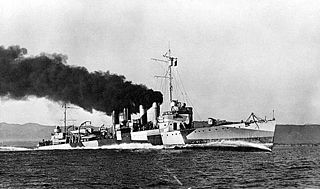
USS Ward was laid down as a 1,247-long-ton (1,267 t) Wickes-class destroyer in the United States Navy during World War I, later converted to a high speed transport in World War II. She was responsible for the first American-caused casualties in the Pacific in World War II when she engaged and sank a Japanese midget submarine before Japanese aircraft arrived in the attack on Pearl Harbor, killing both crewmen on board.

Isaac Campbell Kidd was a rear admiral in the United States Navy. He was the father of Admiral Isaac C. Kidd Jr. Kidd Sr. was killed on the bridge of USS Arizona during the Japanese attack on Pearl Harbor. The highest-ranking casualty at Pearl Harbor, he became the first U.S. Navy flag officer killed in action in World War II as well as the first killed in action against any foreign enemy.

The USS Arizona Memorial, at Pearl Harbor in Honolulu, Hawaii, marks the resting place of 1,102 of the 1,177 sailors and Marines killed on USS Arizona during the attack on Pearl Harbor on December 7, 1941, and commemorates the events of that day. The attack on Pearl Harbor led to the United States' involvement in World War II.

Sammy Kaye was an American bandleader and songwriter, whose tag line, "Swing and Sway with Sammy Kaye", became one of the most famous of the Big Band Era. The expression springs from his first hit single in 1937, "Swing and Sway". He was the first to record and release the standard "Blueberry Hill" in 1940. During World War II, he co-wrote and recorded the anthemic "Remember Pearl Harbor". He was the first to record and release the no. 1 song "Daddy" in 1941. His signature tune was "Harbor Lights", a number-one hit in 1950.
Various unproven conspiracy theories allege that U.S. government officials had advance knowledge of Japan's December 7, 1941, attack on Pearl Harbor. Ever since the Japanese attack, there has been debate as to why and how the United States was caught off guard, and how much and when American officials knew of Japanese plans for an attack. In September 1944, John T. Flynn, a co-founder of the non-interventionist America First Committee, launched a Pearl Harbor counter-narrative when he published a 46-page booklet entitled The Truth about Pearl Harbor, arguing that Roosevelt and his inner circle had been plotting to provoke the Japanese into an attack on the U.S. and thus provide a reason to enter the war since January 1941. Flynn was a political opponent of Roosevelt, and had strongly criticized him for both his domestic and foreign policies. In 1944, a congressional investigation conducted by both major political parties provided little by way of vindication for his assertions, despite Flynn being chief investigator.
Pearl Harbor is a lagoon harbor on the island of Oʻahu, Hawaiʻi, west of Honolulu.

Saburō Kurusu was a Japanese career diplomat. He is remembered now as an envoy who tried to negotiate peace and understanding with the United States while the Japanese government under Emperor Shōwa was secretly preparing the attack on Pearl Harbor.

The "Day of Infamy" speech, sometimes referred to as the Infamy speech, was a speech delivered by Franklin D. Roosevelt, the 32nd president of the United States, to a joint session of Congress on December 8, 1941. The previous day, the Empire of Japan attacked United States military bases at Pearl Harbor and the Philippines, and declared war on the United States and the British Empire. The speech is known for its famed first line, which opened with Roosevelt saying, "Yesterday, December 7, 1941—a date which will live in infamy..."
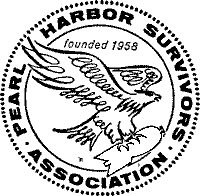
The Pearl Harbor Survivors Association (PHSA), founded in 1958 and recognized by the United States Congress in 1985, was a World War II veterans organization whose members were on Pearl Harbor or three miles or less offshore during the Japanese attack on Pearl Harbor, on December 7, 1941. The PHSA was officially disbanded at the end of December 2011 with a membership of about 2,700 members nationally.

Commander Thomas Calloway Latimore was an American naval officer who was captain of USS Dobbin, and the governor of American Samoa. His disappearance in Hawaii, just months before the 7 December 1941 attack on Pearl Harbor, remains an unsolved mystery.

Kenneth Marlar Taylor was a United States Air Force officer and a flying ace of World War II. He was a new United States Army Air Corps second lieutenant pilot stationed at Wheeler Field during the Japanese attack on Pearl Harbor on December 7, 1941. Along with his fellow pilot and friend George Welch, Taylor managed to get a fighter plane airborne under fire. Taylor claimed to have shot down four Japanese dive bombers but only two were confirmed. Taylor was injured during the incident and received several awards for his efforts, including the Distinguished Service Cross and the Purple Heart.
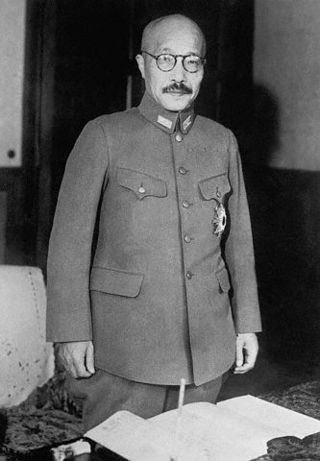
Japan's attack on Pearl Harbor took place on December 7, 1941. The United States military suffered 19 ships damaged or sunk, and 2,403 people were killed. Its most significant consequence was the entrance of the United States into World War II. The US had previously been officially neutral but subsequently entered the Pacific War, and after Italy's declaration of war and Germany's declaration of war shortly after the attack, the Battle of the Atlantic and the European theatre of war. Following the attack, the US interned 120,000 Japanese Americans, 11,000 German Americans, and 3,000 Italian Americans.

Pearl Harbor is an American lagoon harbor on the island of Oahu, Hawaii, west of Honolulu. It was often visited by the naval fleet of the United States, before it was acquired from the Hawaiian Kingdom by the U.S. with the signing of the Reciprocity Treaty of 1875. Much of the harbor and surrounding lands are now a United States Navy deep-water naval base. It is also the headquarters of the United States Pacific Fleet. The U.S. government first obtained exclusive use of the inlet and the right to maintain a repair and coaling station for ships here in 1887. The surprise attack on the harbor by the Imperial Japanese Navy on December 7, 1941, led the United States to declare war on the Empire of Japan, marking the United States' entry into World War II.
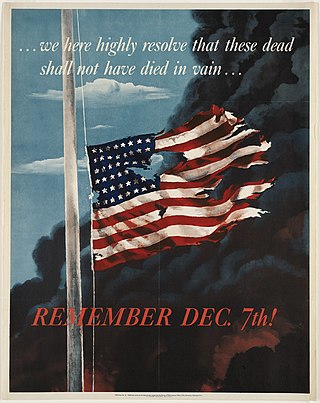
National Pearl Harbor Remembrance Day, also referred to as Pearl Harbor Remembrance Day or Pearl Harbor Day, is observed annually in the United States on December 7, to remember and honor the 2,403 Americans who were killed in the Japanese surprise attack on Pearl Harbor in Hawaii on December 7, 1941, which led to the United States declaring war on Japan the next day and thus entering World War II.

The attack on Pearl Harbor has received substantial attention in popular culture in multiple media and cultural formats including film, architecture, memorial statues, non-fiction writing, historical writing, and historical fiction. Today, the USS Arizona Memorial on the island of Oahu honors the dead. Visitors to the memorial reach it via boats from the naval base at Pearl Harbor. The memorial was designed by Alfred Preis, and has a sagging center but strong and vigorous ends, expressing "initial defeat and ultimate victory". It commemorates all lives lost on December 7, 1941.
Remember Pearl Harbor was a slogan or saying popular in the United States after the Japanese attack on Pearl Harbor on December 7, 1941. Commander Lewis Preston Harris first coined the phrase "Remember Pearl Harbor".
"Remember Pearl Harbor" is an American patriotic march written by Don Reid and Sammy Kaye in the week immediately following the December 7, 1941 attack on the military facilities on the Hawaiian island on Oahu by naval forces of the Japanese navy. Sammy Kaye released a recording of the song on RCA Victor in 1942. The recording reached no. 3 on the Billboard chart.















